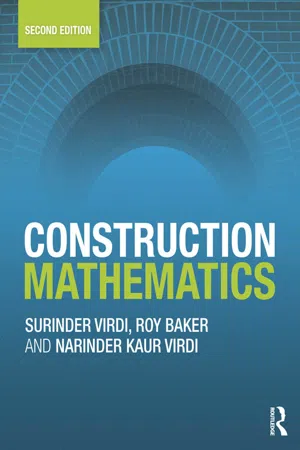Physics
Unit Conversion
Unit conversion in physics refers to the process of changing a quantity from one unit to another. This is often necessary when working with different measurement systems or when comparing data from different sources. The conversion is typically done using conversion factors or equations that relate the original unit to the desired unit.
Written by Perlego with AI-assistance
Related key terms
4 Key excerpts on "Unit Conversion"
- eBook - ePub
Dimensional Analysis
Practical Guides in Chemical Engineering
- Jonathan Worstell(Author)
- 2014(Publication Date)
- Butterworth-Heinemann(Publisher)
Note that we cannot physically combine; i.e., multiply, two sticks, each a foot long, but we can mathematically manipulate the multiples of each stick since the multiples are pure numbers. However, for convenience, we can change the notation of our standard unit to match the dimension of our physical quantity. In other wordsYou may wonder why we belabor this point. It is simple: we always confuse dimension and unit. We must remember that dimension defines a physical quantity and stipulates the procedures required to transform that physical quantity into a physical magnitude. On the other hand, a standard unit provides a scale with which to obtain the fraction of or multiple of the standard unit that comprises the physical magnitude.3.3 Systems of Units
A unit is a specified quantity for a given dimension; thus, it allows us to create physical magnitudes. We can establish, in any fashion, a unit to determine the magnitude of a specified dimension, just so long as we follow the approved procedure for using that unit. For example, the standard unit of length the scientific community established in 1889 and used until 1960 was the International Meter, defined as the length between two engraved lines on a bar of 90% platinum, 10% iridium. After 1960, the scientific community defined the standard unit of length as 1,650,763.73 vacuum wavelengths of 6058 Å light emitted by a Krypton-86 discharge tube. We call this length the optical meter. The accuracy for the platinum–iridium bar is 1/(1×106 ), whereas the optical meter has an accuracy of 1/(1×108 ).1(pp40–43) The scientific community redefined the optical meter in 1983. It is now the distance traveled by light in vacuum in 1/299,792,458 s. ASTM International provides a library of procedures for specifying standard units and for using standard units for measurement.Units can be extensive or intensive. Extensive units sum to become larger. Length has an extensive unit, e.g., 5 ft of rope may be one piece or it may be five, 1 ft rope segments joined together. Mass has an extensive unit. On the other hand, intensive units do not sum to become larger, e.g., temperature, density, and viscosity have intensive units.4 –6 - eBook - ePub
- Surinder Virdi, Roy Baker, Narinder Kaur Virdi(Authors)
- 2014(Publication Date)
- Routledge(Publisher)
CHAPTER 9Units and their conversion
Learning outcomes: (a) Use graphs and conversion factors to convert the units of length, mass, area and volume from one system to the other (b) Use tables to convert the units of temperature9.1 Introduction
Units of measurement, in one form or another, have been with us for many centuries. It is quite likely that the units for length and mass were the first ones to be invented. Our ancestors used the body parts as measuring instruments. Early Babylonian, Egyptian and other records indicate that length was measured with the forearm, hand or fingers. As civilisations evolved, units of measurement became more complicated to cater for trade, land division, taxation and other uses. As the means of communication were not very good before the eighteenth century, different units were developed in different countries, or even different parts of the same country, for the same purpose. In Britain, units from Egyptian, Babylonian, Anglo-Saxon and other European cultures evolved into the inch, foot and yard. In Britain and many other countries, the FPS system had been in use till the late 1950s. The basic units for length, mass and time were the foot, pound and second.During the 1960s scientists and mathematicians started to use the metric system to simplify their calculations and promote communication across different nations. Even in the metric system two branches of systems co-existed for a long time: the CGS and MKS systems. The base units for length, mass and time, in the two systems are:CGS system the centimetre, gram and second MKS system the metre, kilogram and second. In 1960 the metric system was revised and simplified for international use. The metre, kilogram and second were kept as the basic units for length, mass and time. This system, which includes four other basic units, is called the SI system (International System of Units). A brief comparison of the metric systems and the FPS system is given in Table 9.1 - eBook - ePub
- Atef Korchef(Author)
- 2022(Publication Date)
- CRC Press(Publisher)
2 Measurements
DOI: 10.1201/9781003257059-22.1 Objectives
At the end of the present chapter, the student should be able to:- Select the appropriate units in the International System of Units (known by the international abbreviation SI) of measurement.
- Differentiate between fundamental quantity and derived quantity.
- Convert units.
- Define and use the basic methods and tools of measurements, such as significant figures and rounding off.
2.2 Measurements
Measurement is the process of comparing an unknown quantity with another known quantity of the same kind to find out how many times the first includes the second.- Physical quantities are either fundamental (basic) quantities or derived quantities.
- Fundamental quantities cannot be defined in terms of other physical quantities.Examples: length, time, mass, temperature and amount of a substance.
Quantity consists of a number telling us how much, and a unit which shows what the scale of measurement is. Examples of base units in SI are given in Table 2.1 . SI base units of mass, temperature and amount of a substance (kg, K and mol, respectively) are widely used by chemists (Table 2.1 ).TABLE 2.1 Examples of SI base units
Note that:Base quantity SI base unit Name Symbol Name Symbol Length l, x, r, etc meter m Mass m kilogram kg Time t second s Temperature T Kelvin K Amount of a substance n mole mol - The SI unit of mass is kg (with small or lowercase k), not Kg (with capital K).
- The SI unit of the amount of a substance (mole) is denoted by mol (without an “e”), not mole. Also, kg is not the SI base unit for the amount of a substance but the SI unit of mass.
- eBook - ePub
- P.K. Jayasree, K Balan, V Rani(Authors)
- 2021(Publication Date)
- CRC Press(Publisher)
One of the most important operations in engineering is the measurement of physical quantities. Every quantity is measured in terms of some arbitrary, but internationally accepted units, called fundamental units. All the physical quantities, met with in Applied Mechanics and Strength of Materials, are expressed in terms of three fundamental quantities, i.e., Length, Mass, Time, and the corresponding fundamental units are meter (m), kilogram (kg), and second (s), respectively.2.2.1.1 Meter
The international meter may be defined as the shortest distance (at 0°C) between two parallel lines engraved upon the polished surfaces of the Platinum-Iridium bar, kept at the International Bureau of Weights and Measures at Sevres near Paris.2.2.1.2 Kilogram
The International kilogram may be defined as the mass of the Platinum-Iridium cylinder, which is also kept at the International Bureau of Weights and Measures at Sevres near Paris.2.2.1.3 Second
The fundamental unit of time for all the four systems is second, which is 1/(24 × 60 × 60) = 1/86,400th of the mean solar day. A solar day may be defined as the time interval between the instants at which the sun crosses the meridian on two consecutive days. This value varies throughout the year. The average of all the solar days, of one year, is called the mean solar day.2.2.2 Derived Units
Sometimes, physical quantities are expressed in terms of other units, which are derived from fundamental units and they are known as derived units, e.g., units of area, velocity, acceleration, pressure, etc.The base units of the SI system are those from which all other units are derived. For completeness, all seven base units are given in Table 2.1 , derived units are given in Table 2.2 , supplementary units are given in Table 2.3 , and the prefixes that are commonly added to the names of base units given in Table 2.4
Index pages curate the most relevant extracts from our library of academic textbooks. They’ve been created using an in-house natural language model (NLM), each adding context and meaning to key research topics.



